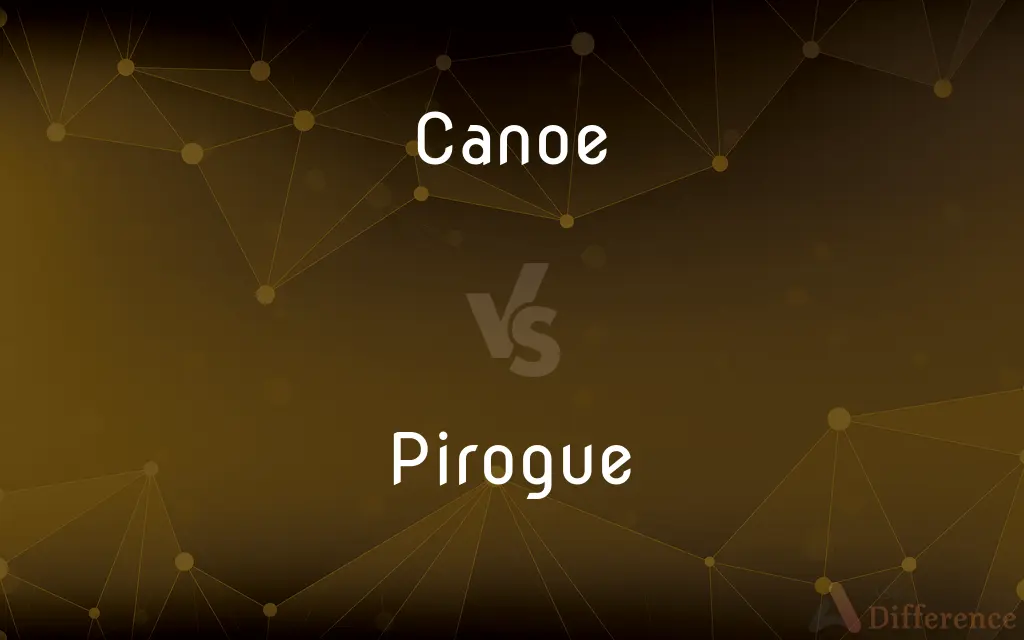Canoe vs. Pirogue — What's the Difference?
By Urooj Arif & Maham Liaqat — Updated on April 2, 2024
A canoe is a narrow, lightweight boat pointed at both ends, used globally, while a pirogue is a flat-bottomed boat, similar in shape but traditionally used in the bayous of the Southern US and West Africa, often for shallow waters.

Difference Between Canoe and Pirogue
Table of Contents
ADVERTISEMENT
Key Differences
A canoe is characterized by its narrow, lightweight design, pointed at both ends, and is propelled by paddles. On the other hand, a pirogue is a specific type of canoe often associated with the bayous of the Southern United States and regions of West Africa. It features a flat-bottom design, making it particularly suitable for navigating shallow waters and swamps. Pirogues are traditionally made from a single tree trunk but can also be constructed from modern materials.
While canoes are designed for speed and efficiency in a variety of water conditions, including rivers and lakes, pirogues are optimized for stability and ease of maneuvering in narrow, shallow waters. The flat bottom of a pirogue allows it to glide over submerged vegetation and navigate through areas where other boats might become stuck. This makes pirogues ideal for fishing and hunting in marshy or swampy areas.
Canoes typically have an open deck design, with the paddler or paddlers seated or kneeling directly on the bottom of the boat, using single-bladed paddles to propel and steer. Pirogues, while similar in this aspect, often have a very low freeboard (the distance from the waterline to the top of the hull), which allows for easy access to the water for fishing or to reach overhanging vegetation.
The cultural significance of each boat type varies greatly. Canoes have been used by indigenous peoples around the world for thousands of years and play a significant role in cultural traditions and histories. Pirogues, while also of significant cultural importance, are closely associated with specific regions, such as the Cajun and Creole cultures of Louisiana and various West African communities, where they are integral to daily life and livelihood.
In terms of construction, modern canoes and pirogues share similar materials, including wood, fiberglass, and plastic. However, the traditional construction methods reflect the cultural heritage and available resources of their respective regions, with pirogues often being hand-carved from single logs, a technique that emphasizes the craftsman's skill and the natural beauty of the wood.
ADVERTISEMENT
Comparison Chart
Design
Narrow, lightweight, pointed ends
Flat-bottomed, suited for shallow waters
Usage
Transportation, recreation, fishing globally
Fishing, hunting in bayous, swamps in the Southern US, West Africa
Construction Material
Wood, aluminum, fiberglass
Traditionally single tree trunk, also modern materials
Water Conditions
Versatile for various conditions
Optimized for shallow, swampy areas
Cultural Significance
Significant worldwide, indigenous traditions
Regionally significant, e.g., Cajun, Creole, West African cultures
Propulsion
Paddled, single-bladed paddles
Paddled, similar but adapted to shallow waters
Stability vs. Speed
Designed for speed and efficiency
Designed for stability and ease of maneuvering
Deck Design
Open deck, seated or kneeling paddlers
Low freeboard, easy water access
Historical Use
Used by indigenous peoples worldwide
Associated with specific cultures and regions
Compare with Definitions
Canoe
Made from various materials for efficiency.
Their fiberglass canoe glided smoothly through the water.
Pirogue
Used for fishing and hunting in marshy areas.
Early morning is the best time for taking the pirogue out for fishing.
Canoe
Versatile for transportation and recreation.
Our family enjoys canoeing down the river each summer.
Pirogue
Low freeboard for easy water access.
He leaned over the side of the pirogue to pull in the crab traps.
Canoe
A lightweight boat pointed at both ends.
They paddled the canoe across the lake at dawn.
Pirogue
Traditionally carved from a single log.
The craftsman displayed his skill in shaping the pirogue.
Canoe
Culturally significant worldwide.
The canoe festival celebrates indigenous watercraft traditions.
Pirogue
Common in the Southern US and West Africa.
Pirogues are essential for fishing in the bayous.
Canoe
Requires skill in paddle use.
He demonstrated how to steer the canoe with a J-stroke.
Pirogue
A flat-bottomed boat ideal for shallow waters.
They navigated the swamp in a pirogue, observing the wildlife.
Canoe
A canoe is a lightweight narrow water vessel, typically pointed at both ends and open on top, propelled by one or more seated or kneeling paddlers facing the direction of travel and using a single-bladed paddle.In British English, the term "canoe" can also refer to a kayak, while canoes are then called Canadian or open canoes to distinguish them from kayaks. Canoes were developed by cultures all over the world, including some designed for use with sails or outriggers.
Pirogue
A pirogue ( or ), also called a piragua or piraga, is any of various small boats, particularly dugouts and native canoes. The word is French and is derived from Spanish piragua [piˈɾaɣwa], which comes from the Carib piraua.
Canoe
A light, slender, usually open boat that has pointed ends and is propelled by paddles.
Pirogue
A canoe made from a hollowed tree trunk; a piragua.
Canoe
To carry or send by canoe.
Pirogue
Any of various boats usually propelled by paddling or poling, especially a light flatbottom boat with pointed ends.
Canoe
To travel in or propel a canoe.
Pirogue
A canoe of shallow draft, made by hollowing a log.
Canoe
A small long and narrow boat, propelled by one or more people (depending on the size of canoe), using single-bladed paddles. The paddlers face in the direction of travel, in either a seated position, or kneeling on the bottom of the boat. Canoes are open on top, and pointed at both ends.
Pirogue
A small flat-bottom boat of shallow draft.
Canoe
(slang) An oversize, usually older, luxury car.
Pirogue
(Cajun cooking) A boat-shaped food that is stuffed with seafood.
Canoe
(gambling) Any of the deflectors positioned around a roulette wheel, shaped like upside-down boats.
Pirogue
A dugout canoe; by extension, any small boat.
Canoe
To ride or paddle a canoe.
Pirogue
A canoe made by hollowing out and shaping a large log
Canoe
A boat used by rude nations, formed of trunk of a tree, excavated, by cutting of burning, into a suitable shape. It is propelled by a paddle or paddles, or sometimes by sail, and has no rudder.
Others devised the boat of one tree, called the canoe.
Canoe
A boat made of bark or skins, used by savages.
A birch canoe, with paddles, rising, falling, on the water.
Canoe
A light pleasure boat, especially designed for use by one who goes alone upon long excursions, including portage. It it propelled by a paddle, or by a small sail attached to a temporary mast.
Canoe
To manage a canoe, or voyage in a canoe.
Canoe
Small and light boat; pointed at both ends; propelled with a paddle
Canoe
Travel by canoe;
Canoe along the canal
Common Curiosities
Is one better than the other for fishing?
It depends on the environment. Pirogues are better suited for shallow, vegetation-heavy waters, while canoes are more versatile across various water types.
Are pirogues only made from tree trunks?
Traditionally, yes, but modern pirogues can also be made from materials like fiberglass and plastic.
How do the materials used in modern canoes and pirogues compare in terms of durability?
Modern materials like fiberglass and plastic offer significant durability for both canoes and pirogues, making them resistant to damage and suitable for various water conditions.
Can both canoes and pirogues carry multiple passengers?
Yes, both can carry multiple passengers, depending on their size and design, with larger models designed to accommodate additional people or cargo.
How do cultural significances of canoes and pirogues differ?
Canoes have worldwide cultural significance with deep roots in indigenous traditions, whereas pirogues hold regional significance, particularly in the Cajun and Creole cultures of Louisiana and in West African communities.
How does the cost of a canoe compare to a pirogue?
The cost can vary widely based on the material, size, and craftsmanship, but generally, specialty pirogues can be more expensive due to their specialized design and traditional construction methods.
What maintenance is required for wooden canoes and pirogues?
Wooden canoes and pirogues require regular maintenance, including varnishing and repairs to any cracks or damages to preserve their integrity and appearance.
What makes a pirogue different from a canoe?
A pirogue is a specific type of flat-bottomed canoe, traditionally used in shallow waters, particularly in the Southern US and West Africa.
Can a canoe be used in the same waters as a pirogue?
While canoes are versatile, pirogues are specifically designed for shallow, swampy areas where their flat bottom offers superior stability and maneuverability.
How do the designs of canoes and pirogues affect their storage and transportation?
Canoes, with their streamlined design, can be easier to transport on vehicle roof racks, while pirogues may require flatbeds or trailers due to their wider, flat bottoms.
Are canoes or pirogues easier for beginners to use?
Pirogues might be easier for beginners in shallow and calm waters due to their stability, while canoes offer a balanced challenge in various water conditions.
What types of paddles are used with canoes and pirogues?
Canoes typically use single-bladed paddles, while pirogues, being similar to canoes, also use single-bladed paddles but may be adapted for easier maneuverability in shallow waters.
Can pirogues be used in fast-moving waters like rivers?
Pirogues are best suited for calm, shallow waters and might not perform as well in fast-moving rivers where canoes, designed for speed and maneuverability, excel.
Are there competitive sports that use canoes and pirogues?
Yes, there are competitive sports for both, with canoeing being part of Olympic sports and pirogue racing popular in regional festivals, especially in areas where pirogues are traditionally used.
How do environmental conditions influence the choice between a canoe and a pirogue?
The choice depends on the water type and vegetation. Canoes are preferred in diverse conditions, including open water and rivers, while pirogues are ideal for shallow, vegetated waters, reflecting their specialized design for specific environments.
Share Your Discovery

Previous Comparison
Pride vs. Humility
Next Comparison
Grande vs. VentiAuthor Spotlight
Written by
Urooj ArifUrooj is a skilled content writer at Ask Difference, known for her exceptional ability to simplify complex topics into engaging and informative content. With a passion for research and a flair for clear, concise writing, she consistently delivers articles that resonate with our diverse audience.
Co-written by
Maham Liaqat















































